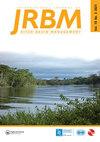Identifying groundwater prospect zones through earth observation techniques in Bilate Watershed, Rift Valley Lakes Basin, Ethiopia
IF 1.9
Q3 WATER RESOURCES
International Journal of River Basin Management
Pub Date : 2023-09-26
DOI:10.1080/15715124.2023.2264268
引用次数: 0
Abstract
AbstractGroundwater is one of the most valuable natural resources gifted to mankind, especially in surface water scarce locations. Most parts of the Ethiopia is dependent on the aminity for common needs, irrigation, etc. Lack of scientific approach in its exploitation and management makes the resource underutilized. Therefore, Remote sensing (RS) and Geographic information system (GIS) were utilized to decipher potential groundwater zones (PGWZ) existing in Bilate watershed of the nation so as to economize, speed up and technicalize the system. Ground truth of the results so obtained was verified to confirm the reliability of the techniques used. Through RS, optical and microwave data were obtained, while GIS was helpful to collect information on water points mapping and 2D resistivity survey in locating the aquifers. Especially, resistivity studies revealed the existence of both pyroclastic and rhyolite intrusions that act as water barriers and the basaltic and ignimbrite rocks that favor aquifer affluence. During the process of identification and quantification of PGWZ in the watershed, analytical hierarchy process (AHP), weighted linear combination (WLC), and digital elevation model (DEM) were employed in thematic layer formation, reclassification, overlay analysis and map production. As a result, five PGWZ having very high (19.8%), high (35.3%), moderate (22.6%), low (19.3%), and very low (2.9%) prospects were identified. Similarly, over 75% of the area was found to be moderate to high category in PGWZ. Accuracy of the qualitative groundwater inventory was proved to be 92.64 percent. Thus, combining high-resolution optical/microwave data and GPS information with AHP model has ascertained the accuracy of PGWZ identified. So ultimately, the present work lays foundation for the use of advanced spatial techniques in finding out natural resources useful for the welfare of the nation and its populace.Keywords: AHP; Bilate watershed; GPSGroundwater potentialSentinel data2D resistivityDisclaimerAs a service to authors and researchers we are providing this version of an accepted manuscript (AM). Copyediting, typesetting, and review of the resulting proofs will be undertaken on this manuscript before final publication of the Version of Record (VoR). During production and pre-press, errors may be discovered which could affect the content, and all legal disclaimers that apply to the journal relate to these versions also. AcknowledgmentsThe authors would like to express special gratitude to Arba Minch University, Water Resources Research Center for financially supporting the study. We are also grateful to the Ethiopian National Meteorological Agency, South Water Works construction enterprise, Ethiopian Geological survey, Ethiopian Mapping Agency, and Ministry of Water, Irrigation, and Electricity for providing the relevant data. The authors also express special thanks to the European Space Agency for enabling the free use of sentinel data from the ESA Sentinel Scientific Data Hub. Finally, we thank Mr. Tigabu Baye, a geologist, who helped during the geophysical survey and interpretation of the 2D resistivity survey. We also wish to thank the two anonymous reviewers, Michael Nones, Editor-in-Chief and Associate Editor, whose suggestions were helpful in significantly improving this manuscript.Availability of data and materialsThe data are available upon request to the authors.Disclosure statementThe authors declare that they have no competing interests.通过地球观测技术在埃塞俄比亚裂谷湖盆地Bilate流域确定地下水远景区
摘要地下水是人类最宝贵的自然资源之一,特别是在地表水匮乏地区。埃塞俄比亚的大部分地区都依赖于海洋的共同需求、灌溉等。由于缺乏科学的开发和管理方法,导致资源利用不足。因此,利用遥感(RS)和地理信息系统(GIS)对全国双侧流域存在的潜在地下水区(PGWZ)进行解译,以实现系统的经济化、快速化和技术化。验证了所得结果的真实情况,以证实所采用技术的可靠性。通过RS获取了光学和微波数据,而GIS则有助于收集水点填图和二维电阻率测量信息来定位含水层。特别是,电阻率研究揭示了火山碎屑岩和流纹岩侵入体的存在,它们可以作为水屏障,而玄武岩和火成岩则有利于含水层的富集。在流域PGWZ识别与量化过程中,采用层次分析法(AHP)、加权线性组合法(WLC)和数字高程模型(DEM)进行主题层形成、重分类、叠加分析和地图制作。结果确定了前景非常高(19.8%)、高(35.3%)、中等(22.6%)、低(19.3%)和极低(2.9%)的5个PGWZ。同样,超过75%的地区被发现在PGWZ中至高类别。地下水定性清查的准确率为92.64%。因此,将高分辨率光学/微波数据和GPS信息与AHP模型相结合,确定了PGWZ识别的准确性。因此,最终,目前的工作为使用先进的空间技术寻找对国家和民众福利有用的自然资源奠定了基础。关键词:层次分析法;Bilate分水岭;免责声明作为对作者和研究人员的服务,我们提供了这个版本的已接受的手稿(AM)。在最终出版版本记录(VoR)之前,将对该手稿进行编辑、排版和审查。在制作和印前,可能会发现可能影响内容的错误,所有适用于期刊的法律免责声明也与这些版本有关。作者要特别感谢阿尔巴明奇大学水资源研究中心对这项研究的财政支持。我们还要感谢埃塞俄比亚国家气象局、南方水厂建设企业、埃塞俄比亚地质调查局、埃塞俄比亚测绘局和水、灌溉和电力部提供的相关数据。作者还特别感谢欧洲航天局免费使用欧空局哨兵科学数据中心的哨兵数据。最后,我们感谢地质学家Tigabu Baye先生,他在地球物理调查和二维电阻率调查的解释期间提供了帮助。我们还要感谢两位匿名审稿人,主编和副主编Michael Nones,他们的建议对本文的显著改进有帮助。数据和材料的可用性这些数据可根据作者的要求提供。声明作者声明他们之间没有利益冲突。
本文章由计算机程序翻译,如有差异,请以英文原文为准。
求助全文
约1分钟内获得全文
求助全文
来源期刊

International Journal of River Basin Management
WATER RESOURCES-
CiteScore
6.00
自引率
4.00%
发文量
48
期刊介绍:
include, but are not limited to new developments or applications in the following areas: AREAS OF INTEREST - integrated water resources management - watershed land use planning and management - spatial planning and management of floodplains - flood forecasting and flood risk management - drought forecasting and drought management - floodplain, river and estuarine restoration - climate change impact prediction and planning of remedial measures - management of mountain rivers - water quality management including non point source pollution - operation strategies for engineered river systems - maintenance strategies for river systems and for structures - project-affected-people and stakeholder participation - conservation of natural and cultural heritage
 求助内容:
求助内容: 应助结果提醒方式:
应助结果提醒方式:


